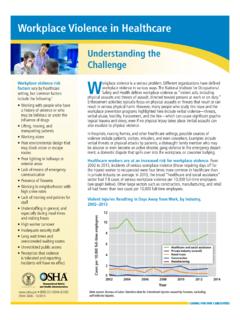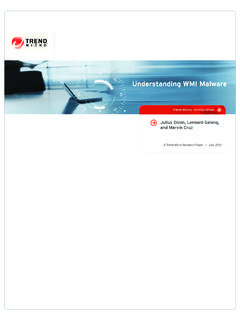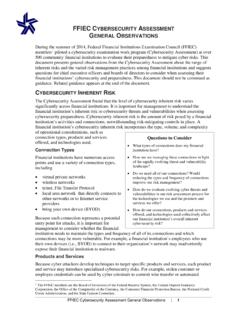Transcription of Shining Light on the Shadow Economy - OECD.org
1 Shining Light on the Shadow Economy : Opportunities and ThreatsThis document, as well as any data and map included herein, are without prejudice to the status of or sovereignty over any territory, to the delimitation of international frontiers and boundaries and to the name of any territory, city or credits: All images courtesy of OECD 20171 Table of contentsSHINING Light ON THE Shadow Economy - OPPORTUNITIES AND THREATSE xecutive summary .. 3 Chapter 1. The nature of the Shadow Economy .. 7 Introduction ..8 How to define the Shadow Economy ? ..8 Examples of Shadow Economy activity ..10 Drivers of the Shadow Economy ..11 Taxpayer attitudes ..12 Industry sectors or taxpayer groups of most concern ..14 Chapter 2. Recent developments in the Shadow 15 Cash still king? ..16 New business models the sharing and gig Economy ..17 Misuse of technology ..19 Fictitious invoices and receipts ..19 Identity fraud ..20 Sales suppression.
2 21 The rise of the cross border Shadow Economy ..21 Non-reporting of offshore income and/or moving untaxed income offshore ..21 VAT carousel fraud ..22 Cross-border traders ..23 Illegal work ..23 Chapter 3. Tax Administration Strategies ..25 Pillar 1: Taxpayer education and simplicity of compliance ..27 Pillar 2: Reducing opportunities/increasing detection ..30 Use of data ..30 Advanced analytics ..33 Technology to reduce ID fraud and reporting fraud ..35 Whole of government approaches ..38 International co-operation ..40 Pillar 3: Reinforcing social norms ..41 Education ..41 Behavioural insights ..42 Support from customers and third disclosure OECD 20172 Shining Light ON THE Shadow Economy - OPPORTUNITIES AND THREATSC hapter 4. Recommendations for further work .. 47 Introduction ..48 Recommendation 1: Sharing of intelligence ..50 Recommendation 2: Effective use of different data sources ..51 Recommendation 3: Collective action on the sharing and gig Economy .
3 51 Recommendation 4: Effective identification and registration ..52 Recommendation 5: Reinforcing social norms ..52 Recommendation 6: Informing whole of government approaches ..54 Recommendation 7: Production of how to guides ..54 Recommendation 8: Measuring impacts ..55 Bibliography .. 56 OECD 20173 Executive summarySHINING Light ON THE Shadow Economy - OPPORTUNITIES AND THREATSW hile the Shadow Economy is a long-standing problem, over the last decade many tax administrations have strengthened their efforts to identify and tackle its different aspects with some success. Many administrations have found the 2012 OECD Forum on Tax Administration (FTA) information note Reducing opportunities for tax non-compliance in the underground Economy ( the 2012 Information Note ; OECD, 2012) helpful in this respect. The 2012 Information Note considered the issues in some depth, stressing the importance of tax administrations having multi-faceted strategies that covered the wide range of Shadow Economy activity.
4 However the Shadow Economy is constantly changing and adapting. In particular recent changes in ways of working and business models, the growth of the digital Economy , wider social changes and globalisation are causing new Shadow Economy activities to emerge and some existing ones to expand in scale or scope. These can create new societal problems and potentially undermine tax compliance more widely. In particular many administrations are seeing a growth in labour market crime, increased cross-border frauds, increasingly sophisticated use of technology within the Shadow Economy and a potential threat to the tax base through opportunities offered by the rapid growth of the sharing and gig economies. It was therefore agreed at the 10th OECD Forum on Tax Administration meeting held in Beijing in May 2016 that it would be timely for the FTA to undertake a project looking at these new developments and how tax administrations should respond, including the possibilities for collaboration between countries and with law enforcement and other agencies.
5 In this respect, this report complements the recently published OECD Technology Tools to Tackle Tax Evasion and Tax Fraud report (OECD, 2017a) as well as the 2012 Information Note. The intention of this report is not to conduct a comprehensive analysis of the Shadow Economy or a review of all the strategies being undertaken by FTA members. Its purpose is more practical, namely to provide an overview of recent developments and some examples of strategies deployed by some tax administrations with the intention of recommending areas of further targeted collective work. The aim is to help keep tax administrations ahead of the game . This work has been sponsored and led by the Norwegian Tax Administration. The work has benefitted from the input and examples provided by a wide range of FTA members and the FTA Secretariat as well as through discussions at an expert workshop with working group members. OECD 20174 The report is split into four chapters:- Chapter 1 examines the drivers and behaviours observed in the Shadow Economy and attempts a new definition of Shadow Economy activity as part of promoting the use of multifaceted strategies, given the complex interlinking of such activities in the modern Economy ;- Chapter 2 looks at the main new trends in Shadow Economy activity focusing on: changing patterns in the use of cash; the emergence of new business models and ways of working; areas where technology can be misused; cross-border Shadow Economy activity, particularly fraud; and the illegal exploitation of workers;- Chapter 3 sets out the range of strategies that tax administrations use to tackle the Shadow Economy , grouping them under three pillars : taxpayer education and simplicity of compliance; reducing the opportunities; and reinforcing social norms.
6 - Chapter 4 sets out recommendations for possible further work. These are: Recommendation 1: Sharing of intelligence: as has been evident in the preparation of this report, tax administrations have much to share on the developing risks in the Shadow Economy , including on cross-border aspects, as well as on effective counter-measures. Tax administrations may want to consider whether a Commissioner sponsored Community of Interest should be established which would bring together experts on the Shadow Economy periodically to complement existing groups for exchanging information. Recommendation 2: Effective use of different data sources: it could be useful to look further at the available data sources, internally generated, domestic and international, including bulk data sources; at how exchange can best be facilitated; and how data sources might be used most effectively to minimise opportunities for carrying out Shadow Economy activity.
7 Recommendation 3: Collective action on the sharing and gig Economy : while the sharing and gig Economy can have positive benefits for the wider Economy , they also risk expanding the Shadow Economy as existing and new activity may go unreported. Given that this development affects all tax administrations, it is worth considering the possible creation of a Task Force made up of interested tax administrations to examine the options, including in discussion with online intermediaries facilitating the sharing and gig Economy , and to propose solutions. Shining Light ON THE Shadow Economy - OPPORTUNITIES AND threats OECD 20175 Shining Light ON THE Shadow Economy - OPPORTUNITIES AND threats Recommendation 4: Effective identification and registration: given the extensive use of false IDs in the Shadow Economy and the importance of effective registration, tax administrations may wish to further explore best practices in identification and registration of taxpayers and in secure authentication, including the use of biometrics and blockchain.
8 Recommendation 5: Reinforcing social norms: as part of multifaceted strategies, tax administrations may wish to explore further the most effective mechanisms to influence behaviour. This might include how third parties, for example customers and trade bodies, can help put downward pressure on the Shadow Economy by increasing transparency and reducing the acceptability of cash payments without electronically recorded receipts. Recommendation 6: Whole of government approaches: actors in the Shadow Economy will often be involved in social security fraud, failure to comply with regulations (including health and safety) and, in some cases, serious crime. Tax administrations are increasingly working with other parts of government on tackling these issues. Tax administrations may wish to consider further the core elements of successful whole of government approaches and how they could help improve overall effectiveness.
9 Recommendation 7: Production of how to guides: A number of tax administrations have introduced successful approaches to tackling aspects of the Shadow Economy , from online tills to innovative uses of data sources and the use of blockchain technology. In order to help other administrations benefit from the lessons of such approaches, some individual tax administrations might wish to provide fuller explanations of how such approaches were planned and implemented. Recommendation 8: Measuring impacts: Measuring the Shadow Economy can be difficult although important for decisions on resources, investment and strategies. Tax administrations may wish to compare approaches to measurement including on how the impact of policies can be most reliably measured. OECD 20176 Chapter 1 OECD 20177 The nature of the Shadow Economy Chapter 1 Chapter 1 OECD 20178 Chapter 1 The nature of the Shadow Economy Shining Light ON THE Shadow Economy - OPPORTUNITIES AND threats IntroductionWhile the Shadow Economy is, by definition, difficult to measure, in general it is seen as a significant part of the tax gap in most countries.
10 Estimates of its size vary from under 1% of Gross Domestic Product (GDP) in some countries to over 20% in others. In addition to less revenue being collected to fund public services, it has other wider effects which can magnify its economic and social impact: it undermines trust in the tax system and the social norms supporting voluntary compliance. This can have a significant impact on compliance attitudes, particularly in the many areas where tax administrations rely on taxpayers to self-declare or self-assess. Where carried out by organised crime, it can also have wider social impacts; it can increase other government and business costs, for example social security costs, loss of regulatory fees and compensation to customers who have suffered financial fraud; it distorts competition, decreasing the costs of non-compliant businesses compared to their competitors. As such it can lead to failures of honest businesses or a spread of Shadow Economy activity; it can put consumers and other businesses at risk, potentially leaving them exposed to credit risk, lack of insurance and health and safety failures; it can lead to the exploitation of workers, for example not paying a minimum wage or lack of contractual protections.


















